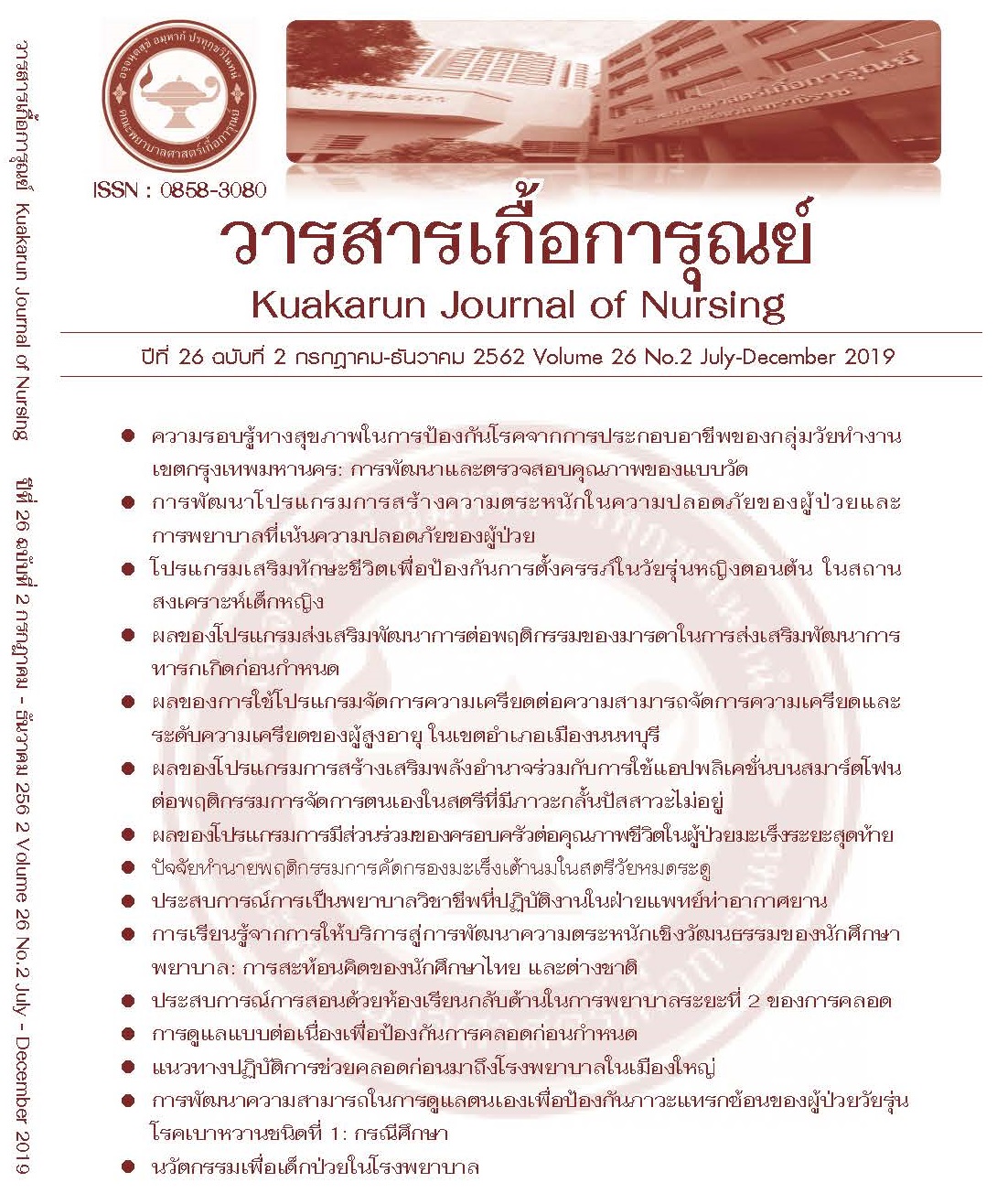Life Skill Development Program to Prevent Teenage Pregnancy among Early Adolescent Girls in Foster Homes
Main Article Content
Abstract
The two-group quasi-experimental research with pretest, posttest and follow-up aimed to examine the result of Life Skill Development Program to prevent teenage pregnancy among early adolescents’ girls in foster homes. The participants (n = 60), were young girls, aged 10 -14, residing in foster homes in Thailand. Each home was randomly assigned to either an experimental or a comparison group (n = 30 each). Life skills were used as the conceptual basis for the teenage pregnancy prevention program. The program included participatory learning and social support. The program was 4 activities: (1) self-assessment improvement; (2) self-awareness about sexual changes and adolescent development; (3) critical thinking about teenage pregnancy, and; (4) learning and, practicing denies and negotiate. The duration of the study was 4 weeks. Thereafter, the participants were assessed on their life skills of self-esteem, self-awareness, critical thinking, ability to deny and negotiate, and on pregnancy prevention behaviors. Data were collected and analyzed using descriptive statistics, and were expressed as percentage, mean, and standard deviation. In addition to using Independent t –test, Chi-square, Likelihood Ratio Fisher’s Exact test, and Two-way repeated measures ANOVA, repeated one-way ANOVA, and post hoc analysis with Bonferroni correction.
The results showed that the experimental group had a mean of difference score of Life Skill on self-awareness and pregnancy prevention behavior significantly higher than that of the comparison group (p < 0.05). Otherwise, there were no statistically difference of Life Skill on self-esteem, critical thinking, and ability to deny and negotiate from before and the comparison group. The program can be applied for enhancing life skill on self-awareness, and pregnancy prevention behavior among female early adolescents in foster homes.
Article Details
References
กรมอนามัย สำนักอนามัยการเจริญพันธุ์. (2561). รายงานประจำปี 2561 สำนักอนามัยการเจริญพันธุ์. สืบค้นจาก https://rh.anamai.moph.go.th/download/all_file/index/reportRH/report_rh_61.pdf
จรีภรณ์ ขวัญดี. (2555). ผลของโปรแกรมพัฒนาทักษะชีวิตต่อการป้องกันการตั้งครรภ์ในวัยรุ่น ในนักเรียนอาชีวศึกษาหญิง จังหวัดสมุทรปราการ.(วิทยานิพนธ์ปริญญาวิทยาศาสตรมหาบัณฑิต สาขาวิชาเอกอนามัยครอบครัว).มหาวิทยาลัยมหิดล. นครปฐม.
ชญาดา คล่องการ. (2556). ประสิทธิผลของโปรแกรมสุขศึกษาในการประยุกต์ใช้การสร้างเสริมทักษะชีวิตร่วมกับแรงสนับสนุนทางสังคมเพื่อป้องกันการตั้งครรภ์ในวัยรุ่น ในโรงเรียนแห่งหนึ่ง อำเภอห้วยแถลงจังหวัดนครราชสีมา. (วิทยานิพนธ์ปริญญาสาธารณสุขศาสตรมหาบัณฑิต สาขาวิชาสาธารณสุขศาสตรมหา-บัณฑิต). มหาวิทยาลัยขอนแก่น. ขอนแก่น.
เนตรทราย ปัญญชุญห์. (2552). การสร้างเสริมทักษะชีวิตเพื่อป้องกันการมีเพศสัมพันธ์ของนักเรียนหญิงมัธยมศึกษาตอนต้น จังหวัดประจวบคีรีขันธ์. (วิทยานิพนธ์ปริญญาวิทยาศาสตรมหาบัณฑิต สาขาวิชาเอกสุขศึกษาและพฤติกรรมศาตร์). มหาวิทยาลัยมหิดล. นครปฐม.
บุญฤทธิ์ สุขรัตน์ (2557). การตั้งครรภ์ในวัยรุ่น: นโยบาย แนวทางการดำเนินงาน และติดตามประเมินผล (พิมพ์-ครั้งที่ 2). กรุงเทพฯ: โรงพิมพ์ชุมนุมสหกรณ์การเกษตรแห่งประเทศไทย.
ปังปอนด์ รักอำนวยกิจ. (2556). แม่วัยใส: สถานการณ์และบริบทในสังคมไทย. โครงการสำรวจและศึกษาเพื่อเฝ้าระวังและเตือนภัยทางสังคมรอบที่ 1 (มิถุนายน-สิงหาคม 2556). กรุงเทพฯ: วิทยาลัยประชากรศาสตร์จุฬาลงกรณ์มหาวิทยาลัย.
พจนา หันจางสิทธิ์และธีรนงค์ สกุลศรี. (2557). ปัจจัยเสี่ยงที่มีผลต่อการตั้งครรภ์ในวัยรุ่น: การศึกษาเชิงคุณภาพ. ใน การประชุมวิชาการระดับชาติ ครั้งที่ 10 “ประชากรและสังคม 2557” (น. 163 – 180). กรุงเทพฯ: มหาวิทยาลัยมหิดล.
พรจิรา ปริวัชรากุล. (2556). แกะรอยหยักสมอง มองผลกระทบของการพนัน. กรุงเทพฯ: สหมิตรพริ้นติ้งแอนด์ พับลิชชิ่ง.
ยงยุทธ วงศ์ภิรมย์ศานติ์และสุวรรณา เรืองกาญจนเศรษฐ์. (2553). ทักษะชีวิต. กรุงเทพฯ: สำนักงานกองทุนสนับสนุนการสร้างเสริมสุขภาพ (สสส.).
ริษา บุนนาค. (2555). ประสิทธิผลของโปรแกรมทักษะชีวิตในการป้องกันพฤติกรรมเสี่ยงทางเพศที่นำไปสู่การมีเพศสัมพันธ์ ของนักเรียนชั้นมัธยมศึกษาตอนต้น จังหวัดนครปฐม. (วิทยานิพนธ์ปริญญาวิทยาศาสตรมหาบัณฑิต สาชาวิชาเอกสุขศึกษาและพฤติกรรมศาสตร์). มหาวิทยาลัยมหิดล. นครปฐม.
วินัดดา ปิยะศิลป์, และพนมเกตุมาน. (2550). ตำราจิตเวชเด็กและวัยรุ่น. กรุงเทพฯ: ธนาเพรส.
สำนักนโยบายและยุทธศาสตร์ กระทรวงสาธารณสุข. (2559). สถิติสาธารณสุข 2546 - 2559. สืบค้นจากhttps://rh.anamai.moph.go.th/download/.../index/.
สุภิญญา อินอิว.(2559). การตั้งครรภ์ในวัยรุ่นและบทบาทการเป็นพ่อแม่. ในรสวันต์ อารีมิตร, สุภิญญา อินอิว,
บุญยิ่ง มานะบริบูรณ์, ศิริไชย หงษ์สงวนศรี และสมจิตร์ จารุรัตนศิริกุล (บ.ก.). ตำราเวชศาสตร์วัยรุ่น: Textbook of adolescent medicine (303 - 322). นนทบุรี: ห้างหุ้นส่วนจำกัดภาพพิมพ์.
สุริยเดว ทรีปาตี. (2551). พัฒนาการและการปรับตัวในวัยรุ่น. สืบค้นจาก https://www.nicfd.cf.mahidol.ac.th/th/.../.../3.pdf.
สุวิดา ศรีฉายแสง. (2558). เหตุและปัจจัยการตั้งครรภ์ไม่พึงประสงค์ของวัยรุ่น กรณีศึกษา: บ้านพักฉุกเฉินและคลินิกวัยรุ่น โรงพยาบาลรามาธิบดี. สืบค้นจากจากhttps://www.crs.mahidol.ac.th/.../.htm.
Cobb, S. (1985). Social support as a moderated of life stress, Psychosomatic Medicine. 38(5). 300 – 314.
Polit, D.F. and Hungler, B.P. (2013). Essentials of nursing research: Methods, appraisal, and utilization (8thed). Philadelphia: Wolters Kluwer/Lippincott Williams and Wilkins.

